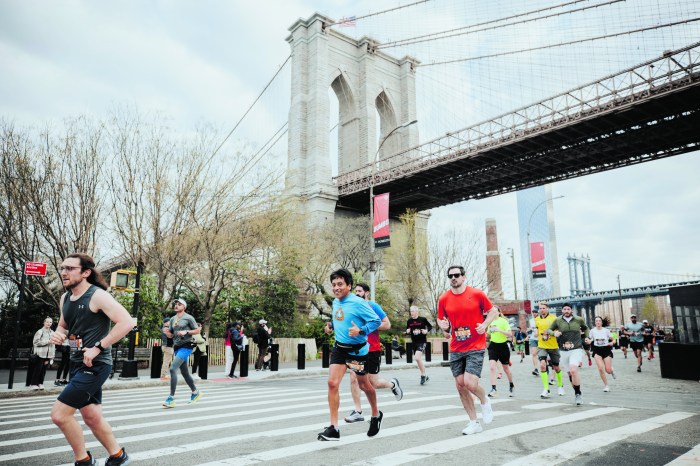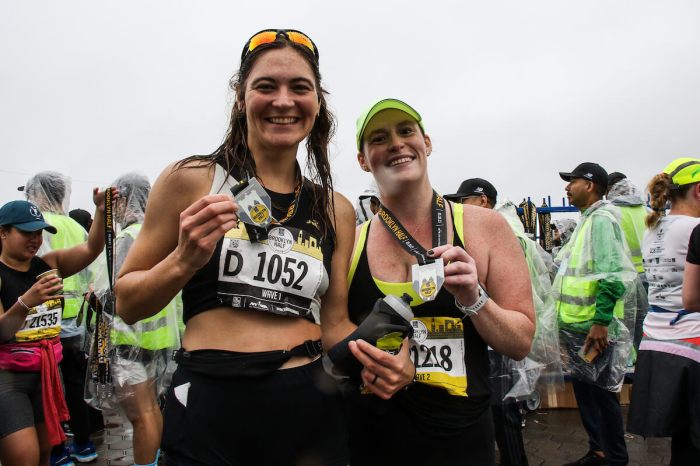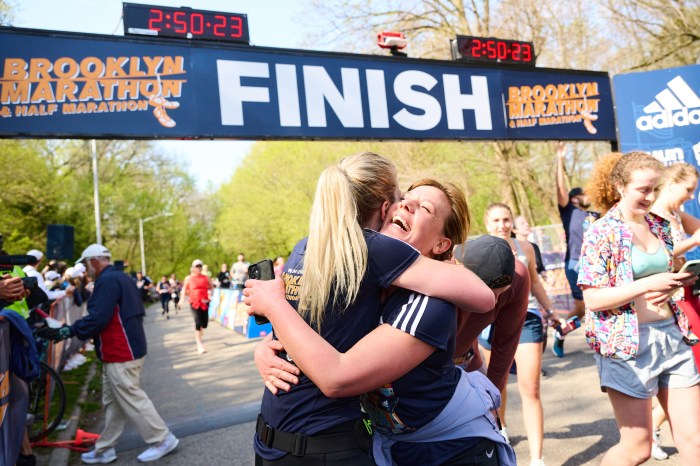There is no excerpt because this is a protected post.
The post Protected: Brooklyn SolarWorks celebrates 10 years of powering change in New York City appeared first on Brooklyn Eagle.
There is no excerpt because this is a protected post.
The post Protected: Brooklyn SolarWorks celebrates 10 years of powering change in New York City appeared first on Brooklyn Eagle.
Just before Christmas, a homeless woman named Debrina Kawam was set on fire while she slept on the F train. In November, a homeless man named Ramon Rivera stabbed three people in Manhattan while suffering from an acute mental health episode. They are familiar stories in New York City, ones that point to the urgent […]
The post Spotlight: The Challenges of Supportive Housing appeared first on Brooklyn Eagle.
There’s a new half marathon in town — kind of.
What was previously the NYCRUNS Brooklyn Half Marathon has been reintroduced as the NYCRUNS Brooklyn Experience Half Marathon after the organization settled a trademark lawsuit with the New York Road Runners.
Aside from its name, the race — scheduled for April 27 — is unchanged. Its 13.1 mile course starts in northern Brooklyn, continues along the Williamsburg waterfront, winds through Fulton Street and Flatbush Avenue, and ends in Brooklyn’s Backyard, Prospect Park.

“The NYCRUNS Brooklyn Experience Half Marathon is more than a race, it’s the ultimate Brooklyn experience,” said NYCRUNS founder and CEO Steve Lastoe, in a statement. “The course is a one-of-a-kind journey through the iconic streets of NYC’s greatest borough. From hip and historic neighborhoods to world-class riverfront views, to the energy created by the city’s most bustling borough, it’s pure Brooklyn.”
What is now the NYCRUNS Brooklyn Experience Half Marathon started in 2011 as the NYCRUNS Brooklyn Marathon, a 26.2-mile race contained entirely within Prospect Park. The race went through several iterations before it became the NYCRUNS Brooklyn Half Marathon in 2023.
That was where the trouble began. The name was almost identical to the New York Road Runners Brooklyn Half Marathon, which had been run in the borough every year for more than 30 years, and Road Runners had trademarked the name “Brooklyn Half Marathon” in the 1980s.
Last year, after the organizations unsuccessfully tried to come to an agreement out of court, Road Runners filed a trademark lawsuit against NYCRUNS, hoping to force a name change.

The suit accused NYCRUNS of choosing a similar name “with the intent to confuse consumers and capitalize on the enormous goodwill” associated with the New York Road Runners.
Court documents — and runners themselves — claimed some people had mistakenly signed up to participate in the NYCRUNS event, instead of the Road Runners race. That was particularly concerning since taking part in Road Runners events can help athletes score a spot in future races.
“In addition, consumers have criticized NYCRUNS’ events as inadequately staffed and poorly organized, which has caused harm to NYRR and to consumers who have been confused by the Infringing Marks and mistakenly run NYCRUNS’ events bearing the Infringing Marks thinking that they were NYRR’s events,” the suit said.
While NYCRUNS initially denied trademark infringement and claimed Road Runners’ trademarks were “weak and unenforceable with respect to the conduct of NYCRUNS,” the two parties quickly decided to work with a private mediator to work out the issue out of court, documents show.

By late October, the parties had agreed to a “settlement in principle,” and they jointly moved to dismiss the lawsuit in December. On Jan. 7, NYCRUNS announced it was “welcoming an old friend with a new name to the streets of Brooklyn,” the newly-renamed WiBrooklyn Experience Half Marathon.
Representatives for NYRR and NYCRUNS confirmed the parties had come to an amicable agreement, but declined to comment further.
“Brooklyn Experience Half Marathon is a pretty good name,” one Reddit user commented on a post about the change.
“Keeping the word ‘Brooklyn’ in the name will still confuse a lot [of] people,” another wrote. “That’s like NYCRUNS creating a marathon in the fall and calling it the iconic ‘New York Marathon’ without the word ‘city’ in the name.”
TENANTS AT THE HYLAN HOUSES AT 131 MOORE STREET in Bushwick are split on how to fund capital repairs that would cost $90 million.
The post Tenants at Hylan Houses in Bushwick split on how to fund repairs appeared first on Brooklyn Eagle.
The Columbian Lawyers Association (CLA) of Brooklyn is more than simply a vehicle for Italian American lawyers and judges to meet.
The post Columbian Lawyers Association of Brooklyn, celebrating the Italian American legal community for nearly 60 years, hold annual meeting on Staten Island appeared first on Brooklyn Eagle.
A collection of topical political cartoons from various artists curated by the Brooklyn Eagle editorial staff.
The post Cartoon Sketchbook: January 9 appeared first on Brooklyn Eagle.
NYC subways saw a sizable increase in ridership almost every day since the launch of congestion pricing on Sunday, according to state data.
Metrics on the New York State open data portal show that the city’s subway ridership on the days following congestion pricing’s launch on Jan. 5 has increased from the same period last year — before the tolls were in effect.
Things started off slow on Jan. 5, with ridership estimated at 1,790,898, down from 3,263,064 the same day in 2024. One caveat in this data is the day upon which Jan. 5 fell between this year and last year; Jan. 5, 2024 was a Friday at the end of a work week; Jan. 5, 2025, was a Sunday.
On Jan. 6 this year, the total estimated ridership was 3,432,808, way up from last year’s 1,942,458 on Saturday, Jan. 6, 2024.
By Jan. 7 — the third day of congestion pricing — an estimated 3,769,916 straphangers rolled through the subway system. This was up from 1,472,438 on Sunday, Jan. 7, 2024.

The three-day ridership total between Jan. 5-7, 2025, was 8,993,622, roughly 34.7% higher than the total for those same three days in 2024, which was 6,677,960.
When comparing the first two Sundays of January year over year, there were 318,460 more riders in 2025, a 21.6% increase from 2024.
And ridership on both workdays Jan. 6 and 7, 2025, was still higher than the ridership reported Friday, Jan. 5, 2024, by 5.2% and 15.5%, respectively.

Meanwhile, congestion pricing is off to a mixed start this week on the roads, with some traffic improvements and some snafus along the way, according to the online Congestion Pricing Tracker.
It is difficult to tell yet if buses are moving faster, but the data shows a similar trend to the subways. Ridership fell from over one million estimated riders last Jan. 5 to 617,326 the first day of congestion pricing.
But buses became more crowded as the week went on.
An estimated 1,228,786 New Yorkers took city buses on Jan. 6, compared to only 684,686 the same day in 2024. City buses drove 1,220,162 passengers around the five boroughs on Jan. 7 this year, versus only 502,518 on the same day in 2024.
Despite the increase in train ridership, many subway straphangers are not even noticing long waits or crowds.
Mindy Katon of the Upper West Side relies on the subway system to get around the city. She told amNewYork Metro that she has not noticed any difference in her travels since the tolls went into effect.
“I took the 1 train both ways, and it’s just as crowded as it was before,” she said.
Carol Zwick, who is also from the Upper West Side, has been riding the 1 train four or five times a week for at least 30 years. She took it once again at 8 a.m. on Thursday with ease.
“I waited four minutes and got a seat,” she said. “It seemed as good as ever.”
But commutes were not so smooth for every New Yorker.
Samantha Nelson, of Staten Island, is a co-parent with her son’s father and often meets him in Brooklyn. She takes the local S79 to Bay Ridge and the R/Q trains to get there.
Most of this week, the wait to get on the trains has been longer than usual.
“It’s like a block and a half more people waiting to board,” she said.
But Thursday was better, she said. The only snag she encountered was an OMNY machine on Staten Island at Bay Street and Victory Boulevard that would not give receipts. But she did not let it ruin her day.
“It’s all good,” she said.
 Welcome to Brooklyn South—your dedication to serving and protecting our community is truly appreciated. Wishing you all a safe and successful journey ahead!
Welcome to Brooklyn South—your dedication to serving and protecting our community is truly appreciated. Wishing you all a safe and successful journey ahead! 
 #NYPD #BrooklynSouth https://t.co/mojZv2upKu
#NYPD #BrooklynSouth https://t.co/mojZv2upKuCongratulations to the 72 new police officer graduates!
Welcome to Brooklyn South—your dedication to serving and protecting our community is truly appreciated. Wishing you all a safe and successful journey ahead!
#NYPD #BrooklynSouth pic.twitter.com/mojZv2upKu
— NYPD Brooklyn South (@NYPDBklynSouth) January 9, 2025
QUOTING MAYOR ADAMS’ State of the City address, State Senator and mayoral candidate Zellnor Myrie (D-20) expressed his own campaign goals.
The post State Senator and mayoral candidate Myrie criticizes Adams’ State of City address appeared first on Brooklyn Eagle.
#SouthCaucasus #SouthCaucasusNewshttps://t.co/zVwc0Atlia https://t.co/yWodfizJE9 pic.twitter.com/RCbgabUcvY
— Michael Novakhov (@mikenov) January 9, 2025